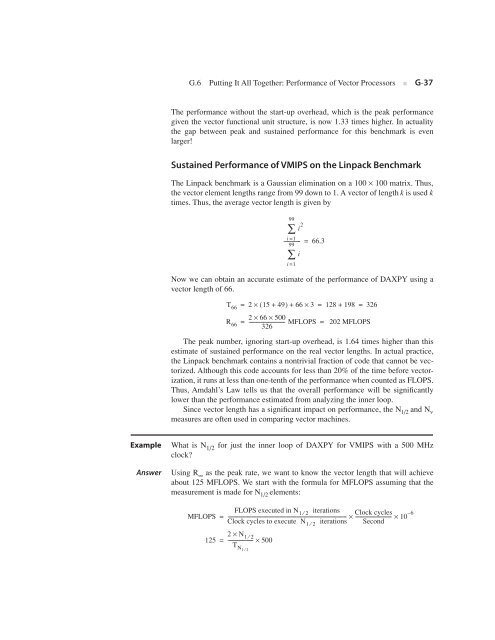Appendix G - Clemson University
Appendix G - Clemson University
Appendix G - Clemson University
Create successful ePaper yourself
Turn your PDF publications into a flip-book with our unique Google optimized e-Paper software.
G.6 Putting It All Together: Performance of Vector Processors ■ G-37<br />
The performance without the start-up overhead, which is the peak performance<br />
given the vector functional unit structure, is now 1.33 times higher. In actuality<br />
the gap between peak and sustained performance for this benchmark is even<br />
larger!<br />
Sustained Performance of VMIPS on the Linpack Benchmark<br />
The Linpack benchmark is a Gaussian elimination on a 100 × 100 matrix. Thus,<br />
the vector element lengths range from 99 down to 1. A vector of length k is used k<br />
times. Thus, the average vector length is given by<br />
i 2<br />
99<br />
∑<br />
i = 1 ------------- = 66.3<br />
99<br />
i<br />
Now we can obtain an accurate estimate of the performance of DAXPY using a<br />
vector length of 66.<br />
The peak number, ignoring start-up overhead, is 1.64 times higher than this<br />
estimate of sustained performance on the real vector lengths. In actual practice,<br />
the Linpack benchmark contains a nontrivial fraction of code that cannot be vectorized.<br />
Although this code accounts for less than 20% of the time before vectorization,<br />
it runs at less than one-tenth of the performance when counted as FLOPS.<br />
Thus, Amdahl’s Law tells us that the overall performance will be significantly<br />
lower than the performance estimated from analyzing the inner loop.<br />
Since vector length has a significant impact on performance, the N 1/2 and N v<br />
measures are often used in comparing vector machines.<br />
Example What is N 1/2 for just the inner loop of DAXPY for VMIPS with a 500 MHz<br />
clock?<br />
i = 1<br />
Answer Using R ∞ as the peak rate, we want to know the vector length that will achieve<br />
about 125 MFLOPS. We start with the formula for MFLOPS assuming that the<br />
measurement is made for N 1/2 elements:<br />
∑<br />
T66 = 2× ( 15+ 49)<br />
+ 66 × 3 = 128 + 198 = 326<br />
R66 =<br />
2× 66× 500<br />
----------------------------- MFLOPS = 202 MFLOPS<br />
326<br />
FLOPS executed in N1⁄ 2 iterations Clock cycles<br />
MFLOPS ------------------------------------------------------------------------------------------------- ------------------------------ 10<br />
Clock cycles to execute N1⁄ 2 iterations Second<br />
6 –<br />
=<br />
×<br />
×<br />
2× N1⁄ 2<br />
125 =<br />
-------------------- × 500<br />
TN1 ⁄ 2

















